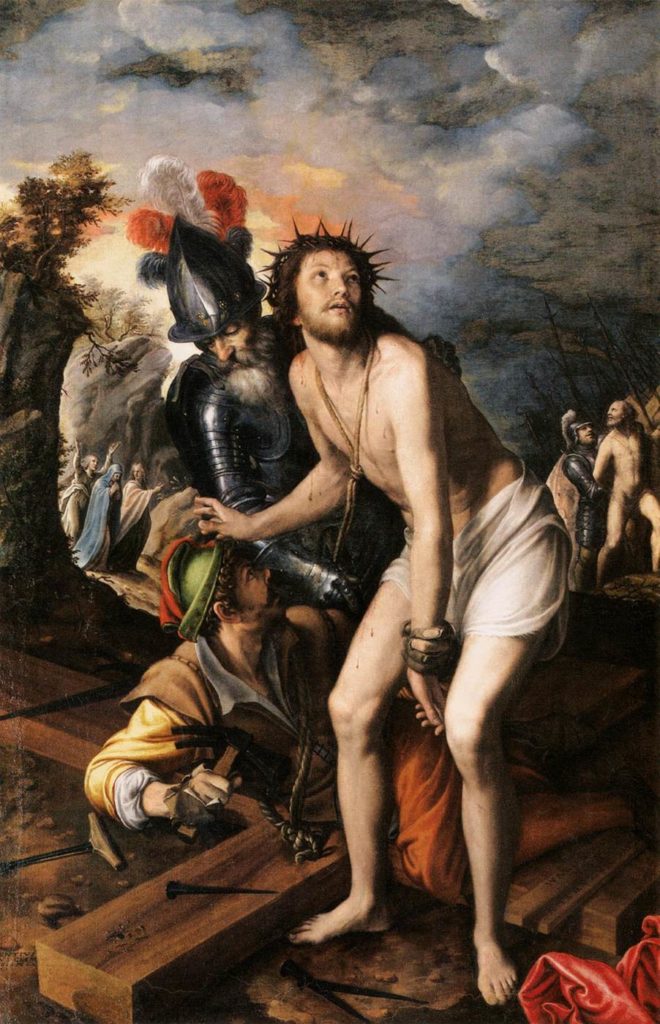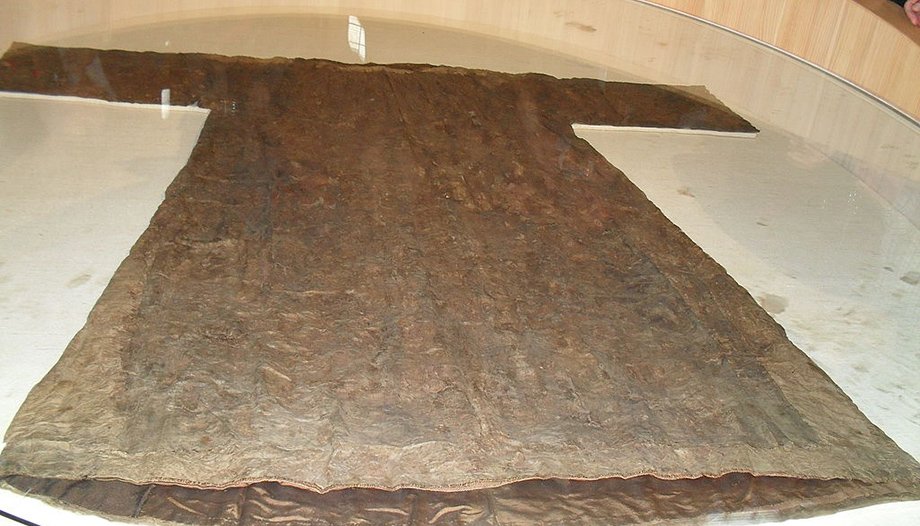The Holy Robe or Holy Tunic is a garment that Jesus wore before being crucified. He would wear it inside other outer garments, and therefore it was not visible.
According to the custom of the time, a Jew - Jesus Christ was a Jew - would wear three garments: an undergarment - an underrobe - an undergarment - an undergarment - an undergarment - an undergarment - an undergarment - an undergarment.interula- more or less long depending on the economic position of the individual, with short sleeves or half sleeves; a long tunic -tunic- and long to the feet; and finally, a cape - a cape that istoga- that was dressed to go out of the house. The tunic could be made of wool, woven in one piece from top to bottom.
The Catholic Church has endowed the holy robe with a very particular symbolism, based on the way it appears in Sacred Scripture. Specifically, from the reference made in the Gospel of John 19:23-24: "When the soldiers had crucified Jesus, they took his clothes and made four parts, one for each soldier. They also took his robeAnd it was seamless, woven in one piece from top to bottom. Then said they among themselves, Let us not divide it, but cast lots for it, to see whose it shall be. This was that the scripture might be fulfilled, which saith, They parted my garments among them, and upon my vesture they cast lots. And so did the soldiers".
Traditional meaning and tokens of piety.
As we will see below, there are three specimens that claim to be the authentic sacred tunic. Faced with this uncertainty -which one would be the true one- the Church can only consider it as a symbol.
The fact that, as the Holy Gospel says, it is a single woven piece, without seams, has led to the allegory of unity as a fundamental feature of the constitution and vitality of the Church. In certain sources it is mentioned that Jesus' garment may have been woven by his Mother, St. Mary.
Also the fact that the holy tunic was not distributed - cut up - among the soldiers, but raffled, has traditionally invited us to consider the confluence in the Church of the human and visible element on the one hand, and on the other the spiritual aspect, the continuous assistance of the Holy Spirit that vivifies it.

There are those who associate the holy robe to the modesty and dignity of man, as opposed to the meaning of the violent outburst by the soldiers when they stripped Jesus, as referred to in the Holy Gospel, which would represent the degrading treatment of the human body according to the vice of impurity.
There are many pious traditions that venerate the holy tunic, such as the multitude of pilgrimages to Trier that have taken place since the early sixteenth century, where, as we shall see below, the most renowned relic of the holy tunic is preserved. It should be noted that since the 20th century these pilgrimages have had an ecumenical character, that is, any Christian, and not only Catholics, are called to them.
Different specimens of the holy tunic. Provenance according to tradition, authenticity and state of conservation.
There are several relics that claim to be the tunic that Our Lord wore before the beginning of his passion or via crucis. They are found in Germany, France and Russia. Each one comes from a different tradition that justifies why they are found where they are.
The Church has not pronounced on the authenticity of any of them, although it admits their veneration as long as they are considered representations that help to live the faith devoutly.
Trier (Germany):
According to tradition, it was the mother of the Roman Emperor Constantine, St. Helena, who in the fourth century recovered the holy tunic on one of her pilgrimages to the Holy Land. However, the accounts that have come down to us of the saint's stay in Jerusalem refer only to the encounter with the cross of Christ, and say nothing about the holy tunic.
It was not until the ninth century that the existence of the holy tunic in Trier was written about, and it is indeed attributed to St. Helena. But between that century and the 19th century it was taken from one place to another -Coblenz, Cologne, Augsburg, among other cities- until it returned to Trier, where it is today.
It is worth noting that Luther himself in the 16th century strongly denigrated the authenticity of the relic and its provenance. He wondered - ridiculing its devout venerators - how it could be that a garment of Christ could be discovered several centuries after the death of Christ, and how it could have come from Palestine to Trier, which was not at all clear. He would accuse the emperor of forging the holy robe in order to reinforce his authority.
In favor of the veracity of the tradition of this version of the holy robe it should be noted that archaeologists have discovered in the excavations of the ancient cathedral of Trier several graffiti attesting to a series of prayers or petitions to Jesus Christ, and in a place separate from the temple, which would justify that there was the relic for the veneration of pilgrims.
As for the state of conservation of the relic, it should be noted that this version of the holy tunic has several layers superimposed on the original for its preservation. And about its age, already in the twentieth century an examination was carried out that dated it to the first century.
Argenteuil (France):
Since the middle of the ninth century we have evidence of the existence of this copy of the holy tunic in the church of the Benedictines of Argenteuil. It also seems to have been in Constantinople and Jerusalem, but Charlemagne transferred it to Argenteuil for its final custody.
Due to Viking attacks, during a certain period the relic was hidden inside a wall of the church, during which time it was not exhibited to the public for veneration. In the middle of the 16th century the Benedictine abbey was burned down; however, the holy robe was preserved, and illustrious personages such as King Henry III, Maria de Medicis, or Louis XIII were able to venerate it. In the 17th century, Pope Innocent X officially recognized such veneration, from which time the relic received many more visits.
At the end of the French Revolution, the Benedictine monastery of Argenteuil was abolished and the holy robe was transferred to the parish church. However, in view of the attacks that other relics were suffering, the abbot decided to cut the tunic into pieces and hide the different parts in different places. The abbot was imprisoned, and when he was released he recovered practically all the pieces of the tunic, and was able to reconstitute it almost in its entirety.
In the 19th century, in order to protect it, its different parts were sewn into a white silk tunic, as a support for these recomposed pieces.
Several studies have been carried out to date it. The most decisive conclusions of its authenticity are those related to its dyeing, which would be from the 1st century. In addition, it was concluded that it was woven in a single piece, and through a procedure similar to that used in Syria and Palestine in the 1st century.
Unlike the Trier Holy Shroud, the Argenteuil one has blood stains. The analyses carried out conclude that they are similar to those of the Turin shroud, even in the blood group, although the first one would present drops of blood from a body in movement - external layer - while the Turin shroud - internal layer - would be that of a static body.
In the 21st century, carbon-14 tests were carried out on the holy tunic, and the date reached was from the 7th century, but it was justified by pointing out that it could be due to a possible contamination of the sample taken into account.
Mtskheta (Georgia):
Finally, after having referred to the holy robes of Trier and Argenteuil, which, although not authentic, do exist, we have a third copy of this relic, which in turn has several versions.
Shortly after the death of Jesus Christ, the relic came into the hands of Sidonia, a young woman living in the Georgian town of Mtskheta, in the Caucasus, today's Georgia.
As with the other versions - German and French - of the Holy Robe, the Mtskheta version would be cut up and distributed throughout St. Petersburg, Moscow, Kiev and other Russian cities. Always for reasons of preservation against possible attacks to its integrity.
Tradition has it that when the Romans cast lots for the tunic of Jesus, a Georgian subject, Elioz, was in Jerusalem. He managed to get hold of the robe and took it to his country, giving it to his sister, Sidonia. The latter, who would be proclaimed a saint, when she saw it, grabbed it with such fervor and impetus that she died on the spot, being buried with her. There would grow a cedar of Lebanon, which would last for centuries and centuries, and before which generations and generations would pray. The first Georgian church would be built on that site, and through the wood of the cedar a series of miracles were worked.
It was from the 11th century that the fame of the relic began to spread. In the 14th century the church of Mtskheta in which the holy robe was deposited was destroyed, but the relic was saved by being preserved until its reconstruction in the treasure chamber.
In the 16th century, an event took place that again reflects the existence of this version of the holy robe: the delivery of the so-called "Georgian holy robe" from the church of Mtskheta to the Muscovite patriarch is documented. It was then that the monastery of the new Jerusalem of Istra was erected in his honor, to which the holy robe was brought.








